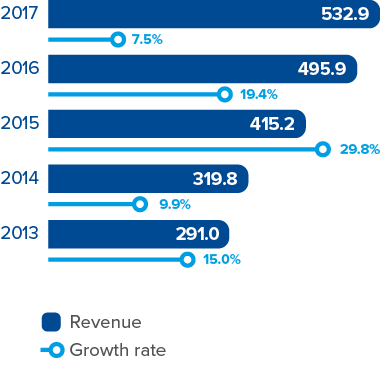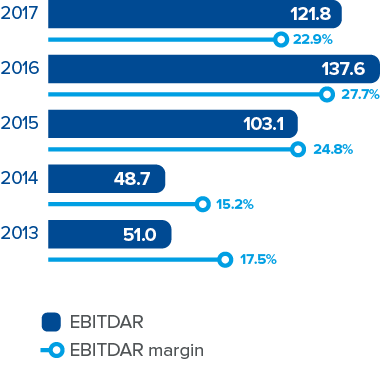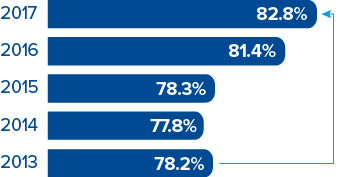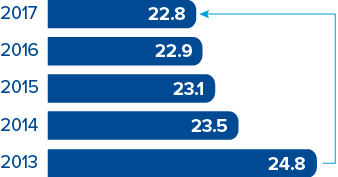Company Profile

Aeroflot is Russia’s biggest carrier, leader of the Russian civil aviation industry, and one of the oldest airlines in the world celebrating its 95th anniversary in 2018. Is based at Moscow Sheremetyevo Airport.



Rossiya is one of Russia’s largest carriers and the market leader in the North-West of the country. Based in Saint Petersburg, the company also operates flights from Moscow’s Vnukovo airport. In addition to its scheduled flights, Rossiya operates charter flights.



Pobeda is a low-cost carrier, launched to improve access to air transportation and further increase social mobility. Is based at Moscow Vnukovo Airport.



Aurora is the Group’s carrier in the Russian Far East. It is based at Vladivostok, Yuzhno-Sakhalinsk, and Khabarovsk airports and operates flights between the key population centres in the Far East and Siberia, regional flights, and flights on the most popular routes.


Results of 2017
2017 marked another major
milestone for Aeroflot
Group with over 50 million
passengers carried. Aeroflot
Group entered the world’s
Top 20 carriers by passenger
traffic, achieving a key goal set
in its Strategy 2025 ahead of
schedule.
The Group took full advantage
of the growing passenger air
transportation market including
scheduled and chartered
flights on both domestic and
international routes. Aeroflot
Group ensured a high utilisation
rate of its much increased
capacity, with the passenger
load factor up to 82.8%.
Operating and Financial Highlights
Passenger traffic MILLION PAX

Passenger load factor %

Passenger turnover BILLION RPK

Available seat-kilometres BILLION ASK

Revenue RUB BILLION

EBITDAR and EBITDAR margin RUB BILLION AND %

EBITDA and EBITDA margin RUB BILLION AND %

Net Profit / (Loss) RUB BILLION

Investment Case
AEROFLOT GROUP
- Leader of the Russian air transportation market, one of the largest carriers in Europe ranked among the world’s Top 20 airlines
- Young and efficient aircraft fleet
- Business highly adaptable to macroeconomic environment
- Promotion of international transfer operations via Moscow
- Stable operational growth and strong financial results
- Long-term vision
2025 GOALS
- Join the Top 5 European airlines by passenger traffic and revenue
- Join the Top 20 global players by passenger traffic and revenue
- Carry over 70 million passengers, including at least 30 million within Russia
- Increase passenger traffic via the main hub in Moscow
- Ensure strong presence in the market
KEY LONG-TERM PERFORMANCE IMPROVEMENTS: 2013–2017



Key Events
Industry Recognition and Awards
.png)
Awards
Aeroflot, for the second year in a row, won
the Air Transport News Readers’ Choice
Award, one of the world’s most prestigious
aviation awards.
Aeroflot won three key categories at the
prestigious international Business Traveller
Russia & CIS Awards 2017, retaining the
titles of the Best European Airline, the Best
Airline in Russia & CIS, and the Best Flight
Attendant’s Uniform.
Aeroflot, for the third time, was named the
Best Russian Airline according to the National
Geographic Traveller Awards 2017.
Aeroflot won two categories at the regional
stage of the World Travel Awards 2017:
Europe’s Leading Airline Brand and Europe’s
Leading Airline – Business Class.
Aeroflot won the High Taste Award
established by Business Traveller, the world’s
leading magazine in the travel industry.
Aeroflot won East Capital’s Best Growth
Award.
Aeroflot, for the third year in a row, won
the prestigious international Randstad
Award as the most attractive Russian
employer in the Transport category.
Aeroflot received a special SAP Expanding
Horizons Award for pioneering SAP Audit
Management system in Russia.
Aeroflot’s in-flight magazine for children,
“Aeroflot. The Young Traveller”, came third
in the international ASTRID Awards.
Aeroflot’s Internal Audit Department won
the Internal Auditor of the Year Award.
Aeroflot’s Legal Department won the Best
Legal Department in Russia – 2017 in the
Transport and Logistics category.
Aeroflot’s Annual Report received
an award in the Best Annual Report
of the Company with the Market
Capitalisation of RUB 40 Billion to RUB
200 Billion category of the Annual Report
Competition hosted by the Moscow
Exchange and the RCB Media Group.
The interactive version of Aeroflot’s 2016
Annual Report received a platinum medal
in the Transport and Logistics category of
the international Vision Awards.
Aeroflot received the TADVISER IT-PRIZE
2017 in the Mobile App of the Year
category.
Aeroflot won three key categories at the prestigious international Business Traveller Russia & CIS Awards 2017, retaining the titles of the Best European Airline, the Best Airline in Russia & CIS, and the Best Flight Attendant’s Uniform.
Aeroflot won two categories at the regional stage of the World Travel Awards 2017: Europe’s Leading Airline Brand and Europe’s Leading Airline – Business Class.
Aeroflot won the High Taste Award established by Business Traveller, the world’s leading magazine in the travel industry.
Aeroflot won East Capital’s Best Growth Award.
Aeroflot received a special SAP Expanding Horizons Award for pioneering SAP Audit Management system in Russia.
Aeroflot’s in-flight magazine for children, “Aeroflot. The Young Traveller”, came third in the international ASTRID Awards.
Aeroflot’s Legal Department won the Best Legal Department in Russia – 2017 in the Transport and Logistics category.
Aeroflot’s Annual Report received an award in the Best Annual Report of the Company with the Market Capitalisation of RUB 40 Billion to RUB 200 Billion category of the Annual Report Competition hosted by the Moscow Exchange and the RCB Media Group.
Aeroflot received the TADVISER IT-PRIZE 2017 in the Mobile App of the Year category.
.png)
High ratings
Aeroflot officially reclaimed its place in
the global aviation elite, having entered
world’s Top 20 largest airlines by passenger
traffic according to Flight Airline Business.
For the second year in row Aeroflot was
ranked 4th globally in the list of digitalised
airlines by Bain & Co.
OAG, a heavyweight British agency, named
Aeroflot as one of the world’s 20 largest
airlines by available seat-kilometres.
Aeroflot was named the world’s leader in
connecting passenger traffic between Europe
and Asia according to a rating compiled by
Airline Network News & Analysis (anna.aero).
Aeroflot came out on top among the
world’s traditional air carriers by capacity
growth (the British OAG’s rating).
Aeroflot topped the Transport category
of Russia’s Top 100 Most Capitalised
Companies according to the RIA Rating
Agency.
Aeroflot was named the Most Child-
Friendly Russian Airline in the travel search
engine Aviasales’ rating.
Flight Airline Business named Pobeda the
world’s top low-cost carrier by revenue
growth.
For the second year in row Aeroflot was ranked 4th globally in the list of digitalised airlines by Bain & Co.
Aeroflot was named the world’s leader in connecting passenger traffic between Europe and Asia according to a rating compiled by Airline Network News & Analysis (anna.aero).
Aeroflot topped the Transport category of Russia’s Top 100 Most Capitalised Companies according to the RIA Rating Agency.
Company History: Key Milestones
AEROFLOT’S HISTORY
represents an era rich in numerous events leading us to Aeroflot’s 95th
anniversary celebrated in 2018. Below are selected milestones that mark the path of Aeroflot’s development.
1923–1940 Take-off
In less than 20 years, by the late 1930s, Aeroflot became the largest airline in the world.9 FEBRUARY 1923 Russian civil aviation was born.
17 MARCH 1923 Joint Stock Company Dobrolet (the Russian Society for Voluntary Air Fleet) was established.
15 JULY 1923 The first scheduled Moscow – Nizhny Novgorod route was launched.
Distance of 420 kilometres
Four passengers
Two flight crew members
26 MARCH 1932 The abbreviated name, “Aeroflot”, was adopted by the Soviet Civil Aviation Fleet, the crew uniform and insignias were introduced.
1940 410 thousand passengers were carried.
1941–1945 Thunderstorm
Since the start of the Great Patriotic War, the Soviet Government suspended all civil aviation flights and Aeroflot switched to supporting the Red Army, with many of its pilots going to the War. Soviet aviators made daily flights to the besieged Leningrad, bringing people food and weapons. One of the hardest and most difficult tasks during the War was ferrying the crucial lend-lease military aircraft supplied by the United States to the USSR via the Alaska–Siberia–Urals route.Over 1.5 million flights were made during the war. Over 20 thousand Aeroflot aviators were decorated with orders and medals. During the war, Aeroflot pilots carried 2.5 million wounded and paratroopers, as well as 300 thousand tonnes of military and strategic cargo. Fifteen Aeroflot employees were awarded the highest title of the Hero of the Soviet Union.
1946–1990 Reaching the flight level
The post-war period saw the air transportation industry recover and grow stronger with Aeroflot becoming the national symbol of progress in aviation. The Company launched the world’s longest routes, operating transatlantic and transcontinental flights, and became the global leader by passenger traffic.The world’s first civilian jet air service using Tu-104 and, later, supersonic Tu-144 was launched. Aeroflot took on the new Soviet aircraft Il-12, Il-14, and Il-18 with higher-speed aircraft enabling flights to the USA, Canada, Cuba, Japan, and other countries.
1959 The new Sheremetyevo airport opens, with its ground service handling the first Aeroflot’s Tu-104 flight from Leningrad to Moscow.
1967 The Flight Attendant Service was established.
1971 The Aeroflot Central Administration of International Air Traffic was set up.
1980 Aeroflot was appointed the XXII Olympic Games general carrier, with the new Sheremetyevo-2 international air terminal inaugurated to support the event.
Aeroflot set an absolute passenger traffic record of 120 million passengers.
1989 Aeroflot became the first Russian airline to join the International Air Transport Association (IATA).
1990-2008 Turbulent times
Following the collapse of the Soviet Union, the unified civil aviation fleet was split into several hundred airlines. However, the state stepped in to prevent unregulated industry fragmentation and saved Aeroflot as a national carrier.Cutting-edge foreign aircraft came into service: Airbus A310-300, Boeing 777-200, Boeing 737-400, and Boeing 767-300ER. The 2008–2009 global financial crisis left the Company in a challenging financial situation.
1992 Joint Stock Company Aeroflot Russian International Airlines was established.
1997 Aeroflot shares started trading on the RTS exchange (Moscow Exchange).
1999 Launch of Aeroflot’s website (www.aeroflot.ru).
2006 Aeroflot became a member of SkyTeam Airline Alliance.
2009–2017 Flying high
A new management team took charge and implemented an anti-crisis action plan including massive fleet additions, the launch of the 24/7 call centre and the new website, the optimized schedule, and improved service standards. New services were launched to enhance passenger experience.10 April 2009 Vitaly Saveliev was appointed as CEO of Aeroflot by the Russian Government.
2011 Aeroflot was awarded the prestigious Skytrax World Airline Award as the Best Airline in Eastern Europe for the first time and successfully lived up to this rating five more times.
2011 Adoption of Aeroflot Group Development Strategy 2025.
2011 As per the resolution of the Russian Government, five regional carriers were transferred from Rostec State Corporation to Aeroflot. Launch of a large-scale integration.
2013 The Internet On-Board programme progressed to the next stage targeting phased rollout of Wi-Fi networks on board all Aeroflot’s wide-body aircraft.
2013 The Group established a unified carrier in the Russian Far East, Aurora airline, through consolidating regional Sakhalin Airways and Vladivostok Avia.
2014 Aeroflot was appointed the official carrier of the XXII Olympic Winter Games and XI Paralympic Winter Games in Sochi.
2014 Launch of Pobeda airline – Group’s low-cost carrier.
2015 100% of Aeroflot’s business processes were digitised.
2016 Aeroflot was certified with the 4 Star airline rating by the global rating agency Skytrax for its high-quality service.
2016 Big Data solutions were introduced as part of Aeroflot’s effort to develop digital projects.
2016 Aeroflot ranked 4th among its global peers by digitalisation.
2016 Aeroflot’s subsidiaries Rossiya, Donavia, and Orenair were consolidated to create a new united carrier, Rossiya Airlines. The Group’s multi-brand platform was finalised.
2016 Big Data solutions were introduced as part of Aeroflot’s effort to develop digital projects.
2016 Aeroflot ranked 4th among its global peers by digitalisation.
2016 Aeroflot’s subsidiaries Rossiya, Donavia, and Orenair were consolidated to create a new united carrier, Rossiya Airlines. The Group’s multi-brand platform was finalised.
2017 Aeroflot Group carried over 50 million passengers, ranking among the Top 20 largest global players.
